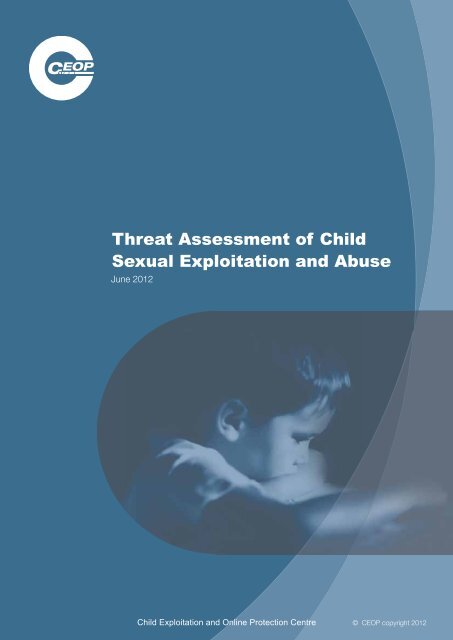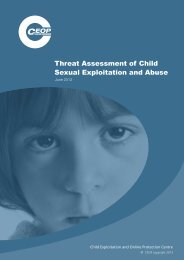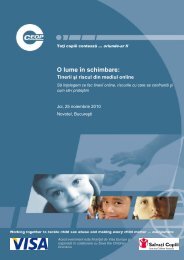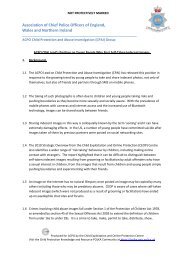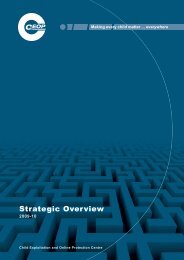Threat Assessment of Child Sexual Exploitation and Abuse - Ceop
Threat Assessment of Child Sexual Exploitation and Abuse - Ceop
Threat Assessment of Child Sexual Exploitation and Abuse - Ceop
You also want an ePaper? Increase the reach of your titles
YUMPU automatically turns print PDFs into web optimized ePapers that Google loves.
Centre Plan 2012-13<br />
<strong>Threat</strong> <strong>Assessment</strong> <strong>of</strong> <strong>Child</strong><br />
<strong>Sexual</strong> <strong>Exploitation</strong> <strong>and</strong> <strong>Abuse</strong><br />
June 2012<br />
<strong>Child</strong> <strong>Exploitation</strong> <strong>and</strong> <strong>and</strong> Online Protection Centre<br />
<strong>Child</strong> <strong>Exploitation</strong> <strong>and</strong> Online Protection Centre<br />
© CEOP copyright 2012
Contents<br />
Section 1: Introduction<br />
Aim <strong>and</strong> scope 5<br />
Information sources <strong>and</strong> limitations 5<br />
Section 2: General Picture <strong>and</strong> Emerging <strong>Threat</strong>s<br />
<strong>Child</strong> sexual exploitation <strong>and</strong> abuse 6<br />
Self generated indecent imagery 6<br />
R<strong>and</strong>omised video chat 7<br />
Social networking 7<br />
The trafficking <strong>of</strong> children to the UK 8<br />
Section 3: Priority Themes<br />
<strong>Threat</strong> <strong>Assessment</strong> <strong>of</strong> <strong>Child</strong> <strong>Sexual</strong> <strong>Exploitation</strong> <strong>and</strong> <strong>Abuse</strong> 2012<br />
1. The targeting <strong>of</strong> children online based on their heightened vulnerability 10<br />
Key findings 10<br />
2. Those who sexually <strong>of</strong>fend against children using the anonymity afforded by the hidden internet 10<br />
Key findings 11<br />
3. The production, distribution <strong>and</strong> possession <strong>of</strong> indecent images <strong>of</strong> children 11<br />
Key findings 12<br />
4. Those who travel overseas to sexually <strong>of</strong>fend against children 12<br />
Key findings 12<br />
5. Group <strong>and</strong> gang associated child sexual exploitation 13<br />
Key findings 13<br />
Section 4: Summary 14<br />
3
Section 1 Introduction<br />
Aim <strong>and</strong> scope<br />
In its new three year strategy 1 CEOP undertakes to assess regularly where <strong>and</strong> how children are most at risk from<br />
sexual exploitation <strong>and</strong> abuse, to communicate this widely <strong>and</strong> develop programmes to mitigate threats. The conduct<br />
<strong>of</strong> this 2012/13 <strong>Threat</strong> <strong>Assessment</strong> on <strong>Child</strong> <strong>Sexual</strong> <strong>Exploitation</strong> <strong>and</strong> <strong>Abuse</strong> (TACSEA) is the primary step towards meeting<br />
that commitment.<br />
The TACSEA is an analysis <strong>of</strong> the threat to the United Kingdom from child sexual exploitation <strong>and</strong> abuse. A restricted version<br />
is produced for law enforcement. The aim is to provide an accurate picture <strong>of</strong> the nature <strong>and</strong> scale <strong>of</strong> current <strong>of</strong>fending<br />
<strong>and</strong> highlight emerging <strong>and</strong> developing trends ins<strong>of</strong>ar as they are a threat in or emanating from the UK. This assessment<br />
represents the most up-to-date underst<strong>and</strong>ing <strong>of</strong> the current level <strong>of</strong> threat posed by child sexual exploitation <strong>and</strong> abuse.<br />
It takes into account information received by CEOP from industry, the public <strong>and</strong> law enforcement. This engagement with<br />
partners allows for current threats to be outlined <strong>and</strong> for the identification <strong>of</strong> areas in need <strong>of</strong> greater underst<strong>and</strong>ing.<br />
The TACSEA reviews the areas identified as priority themes for CEOP in 2011 <strong>and</strong> assesses the extent to which the<br />
<strong>of</strong>fending l<strong>and</strong>scape has changed throughout the year. In keeping with the six strategic objectives set out for the next three<br />
years, the intention is to continue to ensure that the deployment <strong>of</strong> CEOP’s specialist resources is focused on addressing<br />
areas <strong>of</strong> greatest risk.<br />
CEOP will form an integral part <strong>of</strong> the National Crime Agency (NCA), which will be established in 2013. Within the NCA,<br />
CEOP will further develop its strategic approach intended to prevent child sexual exploitation <strong>and</strong> abuse, to protect children<br />
<strong>and</strong> young people who are at risk <strong>of</strong> victimisation <strong>and</strong> to pursue <strong>of</strong>fenders who target children in the UK or overseas.<br />
This threat assessment derives in part from CEOP’s underst<strong>and</strong>ing <strong>of</strong> the similarities between organised crime <strong>and</strong> a large<br />
amount <strong>of</strong> child sexual exploitation <strong>and</strong> abuse. The <strong>of</strong>fending behaviours are <strong>of</strong>ten organised, complex <strong>and</strong> result in serious<br />
harm. As highlighted throughout this report, many individuals coalesce to form online <strong>of</strong>fender networks that are as tightly<br />
controlled as their ‘real world’ equivalents. It is understood that the individuals involved in these networks are generally<br />
unknown to each other <strong>of</strong>fline <strong>and</strong> are commonly not financially motivated. The threat these <strong>of</strong>fenders pose will be mitigated<br />
utilising the full range <strong>of</strong> law enforcement tools <strong>and</strong> assets to prevent the on-going abuse <strong>and</strong> exploitation <strong>of</strong> children both<br />
online <strong>and</strong> in the <strong>of</strong>fline world.<br />
Information sources <strong>and</strong> limitations<br />
<strong>Threat</strong> <strong>Assessment</strong> <strong>of</strong> <strong>Child</strong> <strong>Sexual</strong> <strong>Exploitation</strong> <strong>and</strong> <strong>Abuse</strong> 2012<br />
This analysis is based predominantly on information derived from CEOP’s core business <strong>of</strong> protecting children from harm.<br />
However, in addition to this, pr<strong>of</strong>essional insight <strong>and</strong> research conducted by CEOP staff <strong>and</strong> partners was also utilised.<br />
Whilst much more can be done, the increasing use <strong>of</strong> technology, as well as the enhanced awareness <strong>of</strong> industry, the<br />
general public <strong>and</strong> law enforcement is leading to a corresponding increase in the availability <strong>of</strong> data.<br />
Over recent years a rise has been seen in the levels <strong>of</strong> reporting <strong>and</strong> convictions for sexual <strong>of</strong>fences against children.<br />
However, in this respect we should recognise the potential positive impact <strong>of</strong> national campaigns to combat sexual abuse,<br />
changes to legislation, public policy <strong>and</strong> public awareness, as well as the work <strong>of</strong> CEOP <strong>and</strong> shifts in policing priorities,<br />
encouraging the early reporting <strong>of</strong> such crimes. It is arguable that fluctuations such as these reflect an increasing awareness<br />
<strong>and</strong> underst<strong>and</strong>ing <strong>of</strong> such crimes rather than a rise or fall in the number <strong>of</strong> <strong>of</strong>fences being committed against children.<br />
1 CEOP Centre Plan 2012/13. www.ceop.police.uk/publications<br />
5
6<br />
<strong>Threat</strong> <strong>Assessment</strong> <strong>of</strong> <strong>Child</strong> <strong>Sexual</strong> <strong>Exploitation</strong> <strong>and</strong> <strong>Abuse</strong> 2012<br />
Section 2 General Picture <strong>and</strong> Emerging <strong>Threat</strong>s<br />
<strong>Child</strong> sexual exploitation <strong>and</strong> abuse<br />
The most rigorous <strong>and</strong> comprehensive indication <strong>of</strong> the overall prevalence <strong>of</strong> sexual abuse today can be found in a major<br />
study - ‘<strong>Child</strong> <strong>Abuse</strong> <strong>and</strong> Neglect in the UK Today’ 2 which is based on asking a representative sample <strong>of</strong> UK children <strong>and</strong><br />
young people to reflect on their experiences <strong>of</strong> abuse during childhood.<br />
In comparison to their earlier study in 2000, the findings suggest a decline in serious forms <strong>of</strong> contact sexual abuse. In<br />
addition, the level <strong>of</strong> coerced sexual acts against under 16 year olds declined from a 6.8% national prevalence rate in 1998<br />
to 5% in 2009. These findings are consistent with other data.<br />
Additional research has shown a consensus in public perception which identifies ‘stranger danger’ as the most significant<br />
risk in respect <strong>of</strong> sexual <strong>of</strong>fending against children. However, empirical evidence shows that approximately 80% <strong>of</strong> sexual<br />
<strong>of</strong>fences against children are committed within the family or by persons known to the child or children, <strong>of</strong>ten in positions <strong>of</strong><br />
trust. Similarly, approximately 80% <strong>of</strong> sexual <strong>of</strong>fences against children occur in the home <strong>of</strong> either the <strong>of</strong>fender or the victim.<br />
This assessment acknowledges that child sexual exploitation <strong>and</strong> abuse takes place in both online <strong>and</strong> <strong>of</strong>fline environments<br />
<strong>and</strong> that the distinction is in many ways artificial to children <strong>and</strong> young people in 2012.<br />
Self generated indecent imagery<br />
CEOP has seen a marked increase in the number <strong>of</strong> reports where young teenagers appear to have taken still or video<br />
indecent imagery <strong>of</strong> themselves which is then shared online. For the purposes <strong>of</strong> this assessment such material is referred to<br />
by the generic term, ‘self generated indecent imagery’ (SGII). It is worth noting that the distribution methods for SGII can vary<br />
widely. As such, the term encompasses a range <strong>of</strong> behaviours <strong>and</strong> accompanying levels <strong>of</strong> risk.<br />
During 2011/12, CEOP found that SGII is distributed by its author in the following ways (in order <strong>of</strong> prevalence):<br />
8 live one to one video chat on websites;<br />
8 video chat via instant messaging applications;<br />
8 files sent by email to another person;<br />
8 files uploaded to public video hosting websites;<br />
8 files being sent as attachments during online chat sessions; <strong>and</strong><br />
8 files used as pr<strong>of</strong>ile images or posted on social networking websites.<br />
In contrast to the findings <strong>of</strong> the previous TACSEA, the picture in 2012 shows that a vast majority <strong>of</strong> SGII is being freely<br />
produced <strong>and</strong> uploaded to the internet by children without external influence, coercion or threat from adults or others.<br />
SGII are taken for a variety <strong>of</strong> reasons within consensual relationships between young people. These include a private image<br />
taken for a boyfriend or girlfriend or images taken to be used as online pr<strong>of</strong>ile pictures. Often these images are subsequently<br />
posted online or distributed by the person for whom they were intended as a joke, after an argument or once the relationship<br />
has ended. It cannot be discounted, however, that the exchange <strong>of</strong> SGII, whilst it may have been willingly produced by<br />
a young person, can indicate an underlying vulnerability or behavioural concern.<br />
2 NSPCC, 2011.
Section 2 General Picture <strong>and</strong> Emerging <strong>Threat</strong>s<br />
Almost 22% <strong>of</strong> reports received by CEOP from industry in 2011/12 related to the distribution <strong>of</strong> SGII 3 . Whilst the majority <strong>of</strong><br />
SGII is produced by older teenagers, almost a third <strong>of</strong> SGII reported to CEOP in 2011/12 related to children under the age<br />
<strong>of</strong> 15. Occasionally SGII, particularly where it involves a subject under 15, can be the product <strong>of</strong> serious criminal activity<br />
by a third party or may be used for such purposes subsequently. Therefore whilst volumes generally are increasing it is<br />
important not to lose sight <strong>of</strong> the real <strong>and</strong> lasting harm it can cause.<br />
The increase in teenagers’ ownership <strong>of</strong> smart phones, as reported by Ofcom 4 , is likely to result in an increase in the<br />
prevalence <strong>of</strong> SGII production. Two thirds <strong>of</strong> teenagers say they have used their smart phone while socialising with others.<br />
Additionally, a smart phone allows them the means <strong>and</strong> opportunity for unsupervised access to the internet.<br />
The majority <strong>of</strong> self taken imagery received by CEOP is currently assessed to have been intended as a private exchange<br />
between two young people, where children have been involved in consensual sexual activity <strong>and</strong> experimentation. CEOP’s<br />
efforts have focused on identifying <strong>and</strong> safeguarding the child authors <strong>of</strong> SGII. More work can be done, however, to identify<br />
the sliding scale <strong>of</strong> risk <strong>and</strong> harm that accompanies the variety <strong>of</strong> ways in which SGII is being produced <strong>and</strong> distributed,<br />
<strong>and</strong> the extent to which these are driven by the malevolent intentions <strong>of</strong> a third party in grooming, deceiving <strong>and</strong><br />
threatening children.<br />
To protect children better, a greater focus is required on the criminals who actively exploit their victim’s relative vulnerability<br />
through threats <strong>and</strong> intimidation. This aspect is addressed in detail as a priority theme later in this document.<br />
R<strong>and</strong>omised video chat<br />
Throughout 2011, CEOP has noticed an increase in the number <strong>of</strong> reports received relating to r<strong>and</strong>omised, anonymous<br />
video chat services. In the last year there has been a proliferation <strong>of</strong> such websites following the success <strong>of</strong> market leaders.<br />
Sites <strong>of</strong>fer r<strong>and</strong>omly chosen webcam chat sessions, which are engaging for children, but <strong>of</strong>ten expose them to high levels<br />
<strong>of</strong> sexual activity <strong>and</strong> sexualised conversation.<br />
Social networking<br />
<strong>Threat</strong> <strong>Assessment</strong> <strong>of</strong> <strong>Child</strong> <strong>Sexual</strong> <strong>Exploitation</strong> <strong>and</strong> <strong>Abuse</strong> 2012<br />
In 2011, social networking accounted for more than 20% <strong>of</strong> all time spent online 5 . The growth <strong>of</strong> this medium since 2009<br />
has largely been driven by the growth <strong>of</strong> Facebook with an estimated 24.8 million UK users visiting the site each month,<br />
six times more than visited Twitter, the second most popular site. Facebook remains the world’s most prolifically accessed<br />
social networking website, with a wide <strong>and</strong> continually growing membership <strong>of</strong> children.<br />
Whilst children can make themselves vulnerable in relation to their online behaviour it is equally the case that <strong>of</strong>fenders target<br />
<strong>and</strong> exploit this vulnerability. CEOP sees frequent grooming behaviour targeted towards children <strong>and</strong> social networking sites<br />
are the most commonly reported environment in which this activity takes place. This is likely to be due to the ease with which<br />
individuals can create pr<strong>of</strong>iles on such sites.<br />
Criminals use a number <strong>of</strong> methods to build friendships with children on social networking sites. Once a relationship is<br />
formed the <strong>of</strong>fender will use their position to initiate some form <strong>of</strong> sexually exploitative activity, be that in non contact forms<br />
via webcam (as discussed later in this document) or through contact <strong>of</strong>fline.<br />
3 Sample <strong>of</strong> 2293 reports received from the National Centre for Missing <strong>and</strong> Exploited <strong>Child</strong>ren in November 2011.<br />
4 Ofcom Communications Market Report – August 2011.<br />
5 UKOM/Nielsen August 2011.<br />
7
8<br />
<strong>Threat</strong> <strong>Assessment</strong> <strong>of</strong> <strong>Child</strong> <strong>Sexual</strong> <strong>Exploitation</strong> <strong>and</strong> <strong>Abuse</strong> 2012<br />
Section 2 General Picture <strong>and</strong> Emerging <strong>Threat</strong>s<br />
The trafficking <strong>of</strong> children to the UK<br />
The UK continues to be a significant transit <strong>and</strong> destination country for child trafficking, with reporting confirming the<br />
existence <strong>of</strong> child trafficking both into <strong>and</strong> within the UK. <strong>Child</strong>ren are trafficked into the UK from a diverse range <strong>of</strong> countries<br />
for a range <strong>of</strong> reasons <strong>and</strong> the trafficking routes used <strong>and</strong> methodologies employed by traffickers remain varied. CEOP has<br />
recently completed an assessment <strong>of</strong> the trafficking6 <strong>of</strong> children into the UK. The report covers the period from 1st January<br />
2011 to 15th September 2011 <strong>and</strong> highlights the following trends <strong>and</strong> patterns identified from the data.<br />
Overall, Africa, Asia <strong>and</strong> Eastern Europe were the most notable source regions for child trafficking into the UK. Victim<br />
demographics for this reporting period show a number <strong>of</strong> established trends. Across all regions the vast majority <strong>of</strong> victims<br />
were aged 14-17, with relatively low numbers <strong>of</strong> trafficking victims identified for younger age groups. When looking at<br />
gender, there were generally more female victims <strong>of</strong> child trafficking identified than male, with significant differences existing<br />
between regions. The majority <strong>of</strong> victims originating from Africa <strong>and</strong> Eastern Europe were female, whilst from Asia, they were<br />
mostly male. The explanation for these trends is likely to lie in the type <strong>of</strong> exploitation the children were trafficked into the UK<br />
to suffer. Many Eastern European girls, for example are trafficked to the UK for prostitution, whilst many Vietnamese boys are<br />
trafficked to work in the illegal drugs trade. However, intelligence suggests that a number <strong>of</strong> trafficked children are the victim<br />
<strong>of</strong> multiple forms <strong>of</strong> exploitation <strong>and</strong> abuse.<br />
Discussions have taken place between CEOP <strong>and</strong> the United Kingdom Human Trafficking Centre (UKHTC), clarifying<br />
responsibilities in respect <strong>of</strong> the trafficking <strong>of</strong> children into the UK from abroad for sexual purposes. In keeping with its remit,<br />
the UKHTC will take strategic <strong>and</strong> operational primacy for all trafficking into the UK, including where this is for purposes <strong>of</strong><br />
sexual exploitation.<br />
6 Strategic <strong>Threat</strong> <strong>Assessment</strong> <strong>of</strong> <strong>Child</strong> Trafficking in the UK.
Centre Plan 2012-13<br />
<strong>Child</strong> <strong>Exploitation</strong> <strong>and</strong> Online Protection Centre
10<br />
<strong>Threat</strong> <strong>Assessment</strong> <strong>of</strong> <strong>Child</strong> <strong>Sexual</strong> <strong>Exploitation</strong> <strong>and</strong> <strong>Abuse</strong> 2012<br />
Section 3 Priority Themes<br />
1. The targeting <strong>of</strong> children online based on their heightened vulnerability<br />
There are a number <strong>of</strong> ways in which children are persuaded, manipulated, groomed or threatened into performing sexual<br />
activity over webcam or sending indecent images to an adult <strong>of</strong>fender in a way that constitutes non contact sexual abuse.<br />
In many cases this follows a similar pattern to <strong>of</strong>fline grooming where persuasion by the <strong>of</strong>fender for a child to expose<br />
themselves sexually <strong>of</strong>ten gives way to threats <strong>and</strong> intimidation.<br />
In the past year CEOP received reports indicating that children were being incited to perform sexual activity via webcam<br />
by means <strong>of</strong> targeted criminal coercion by <strong>of</strong>fenders. Offenders will use various methods to coerce a child into giving their<br />
username <strong>and</strong> password for a social networking site. Compromising the child’s social networking presence in this way is<br />
used by the <strong>of</strong>fender to get the child to perform sexual acts or send indecent images online. This then forms the basis for<br />
further threats <strong>and</strong> incitement to perform increasingly serious sexual acts.<br />
In such situations, children <strong>of</strong>ten fail to underst<strong>and</strong> the abuse they have suffered. Researchers <strong>and</strong> therapists believe that this<br />
is because <strong>of</strong> children’s heightened sense <strong>of</strong> shame, exposure <strong>and</strong> lack <strong>of</strong> control over the disclosure process. Operational<br />
experience over the last year supports this.<br />
In the online environment, evidence from a study <strong>of</strong> 25,000 children across the European Union in 2011 found that teenagers<br />
reported encountering more risks online than younger children, with 63% <strong>of</strong> 15 <strong>and</strong> 16 year olds reporting one or more forms<br />
<strong>of</strong> illegal or upsetting behaviour online. Significantly, the study also found no discernable difference between the likelihood <strong>of</strong><br />
girls <strong>and</strong> boys encountering such risks online.<br />
Whilst Ofcom’s <strong>Child</strong>ren’s <strong>and</strong> Parents’ Media Use <strong>and</strong> Attitudes report found that the number <strong>of</strong> 12–15 year olds<br />
communicating with people they don’t know in such environments fell by a quarter in 2011 to 24%, a wider report for<br />
EU Kids Online7 identified that almost half <strong>of</strong> 15 <strong>and</strong> 16 year olds across Europe had contact with new people online.<br />
Whilst online grooming for sexual purposes is not new, the use <strong>of</strong> sometimes subtle social engineering techniques to this<br />
end appears to be a relatively recent phenomenon. Without sufficient recognition <strong>and</strong> intervention from law enforcement<br />
there is every likelihood that this trend will grow. With the forecasted growth <strong>of</strong> internet use across the world, particularly<br />
in developing nations, it is also increasingly likely that UK children will also be targeted by <strong>of</strong>fenders based overseas.<br />
Key findings<br />
8 Offenders are targeting children through social networking sites.<br />
8 Offenders use social engineering techniques to gain control over the social networking accounts<br />
<strong>of</strong> young children.<br />
8 Offenders use threats to coerce children into performing harmful <strong>and</strong> degrading sexual activity online.<br />
2: Those who sexually <strong>of</strong>fend against children using the anonymity afforded by the hidden internet<br />
The hidden internet provides a perception <strong>of</strong> anonymity for those surfing or hosting websites. Websites facilitating money<br />
laundering, drug use, trafficking <strong>and</strong> other forms <strong>of</strong> criminality proliferate across such networks with a significant <strong>and</strong><br />
growing use by those with a sexual interest in children. Of course, not all users <strong>of</strong> the hidden internet access these<br />
networks for criminal purposes but the overwhelming majority <strong>of</strong> sites <strong>and</strong> forums available relate to unlawful activity<br />
<strong>of</strong> one form or another.<br />
Hidden internet sites are believed to be a source <strong>of</strong> new or ‘first generation’ indecent images <strong>of</strong> children. Many indecent<br />
images <strong>and</strong> videos are seen for the first time on such sites, suggesting many <strong>of</strong> the users are involved in the production<br />
7 Disadvantaged <strong>Child</strong>ren <strong>and</strong> Online Risk, Livingstone et al, 2011.
Section 3 Priority Themes<br />
<strong>of</strong> the material <strong>and</strong> contact sexual abuse. In some cases children are being abused to order by members <strong>of</strong> forums with<br />
the resulting imagery subsequently shared within the community. In due course, some <strong>of</strong> these first generation images <strong>and</strong><br />
videos find their way onto peer-to-peer (‘P2P’), image hosting <strong>and</strong> social networking sites on the open internet.<br />
CEOP remains committed to targeting all those involved in the production, distribution <strong>and</strong> possession <strong>of</strong> indecent images<br />
<strong>of</strong> children.<br />
Key findings<br />
8 Many UK <strong>of</strong>fenders are using the hidden internet to network <strong>and</strong> distribute IIOC.<br />
8 IIOC are being produced by those using the hidden internet <strong>and</strong> first posted in that environment.<br />
8 Almost half <strong>of</strong> UK hidden internet use is estimated to involve paedophile activities.<br />
3. The production, distribution <strong>and</strong> possession <strong>of</strong> indecent images <strong>of</strong> children<br />
<strong>Threat</strong> <strong>Assessment</strong> <strong>of</strong> <strong>Child</strong> <strong>Sexual</strong> <strong>Exploitation</strong> <strong>and</strong> <strong>Abuse</strong> 2012<br />
In a representative sample <strong>of</strong> 610 actionable reports received by CEOP from industry, 306 (51%) were found to relate to<br />
the production, distribution or possession <strong>of</strong> IIOC (excluding self generated indecent images). The majority <strong>of</strong> these reports<br />
(58%) related to images uploaded to a storage facility or email service <strong>and</strong> approximately 11% were social networking sites8 .<br />
Another principal route for the distribution <strong>of</strong> IIOC is assessed to be peer to peer (P2P) networking or file sharing. These<br />
systems are developing to create a relatively enclosed global network environment for the distribution <strong>of</strong> indecent images<br />
<strong>of</strong> children in both still <strong>and</strong> video form.<br />
A key characteristic <strong>of</strong> a new generation <strong>of</strong> P2P, which sets it apart from conventional facilities, is that in order to share files,<br />
users must first be invited into smaller groups in much the same way as happens in social networking environments. This<br />
means that it is not possible for those outside the group to see which files are available from a particular user.<br />
CEOP is aware <strong>of</strong> a number <strong>of</strong> international investigations that have focused on such P2P services which have resulted in<br />
successful prosecutions. CEOP data suggests that it is predominantly users in the developed world who currently make use<br />
<strong>of</strong> such services as a vehicle for viewing <strong>and</strong> distributing IIOC. With the rapid growth <strong>of</strong> the internet, an increase in the use<br />
<strong>of</strong> P2P technology is likely, particularly in developing countries9 .<br />
Between 2010/11 <strong>and</strong> 2011/12, CEOP has observed an increase in the number <strong>of</strong> <strong>of</strong>fenders identified for producing<br />
IIOC involving multiple victims. Over the same period, CEOP has also seen a rise in the number <strong>of</strong> female IIOC producers<br />
identified, with all but one, acting in collaboration with male <strong>of</strong>fenders.<br />
Observations by CEOP also suggest a rise in <strong>of</strong>fenders taking so called ‘c<strong>and</strong>id’ IIOC <strong>of</strong> multiple child victims covertly in<br />
public <strong>and</strong> private settings. This may be a result <strong>of</strong> technological advancements in still <strong>and</strong> video camera technology over<br />
recent years, with high quality equipment now lending itself to concealed use.<br />
CEOP’s Thematic <strong>Assessment</strong> ‘A Picture <strong>of</strong> <strong>Abuse</strong>’ 10 identifies a strong correlation between those who commit IIOC<br />
possession <strong>of</strong>fences <strong>and</strong> contact <strong>of</strong>fending, <strong>and</strong> explores research <strong>and</strong> practitioner experience to deliver in-depth analysis<br />
<strong>of</strong> this issue.<br />
Peer to peer networks <strong>and</strong> other related technologies are likely to evolve <strong>and</strong> mutate to accommodate changes in legitimate<br />
customer needs. They are also likely to improve their security features, enable new functionality <strong>and</strong> increase the speed<br />
<strong>and</strong> availability <strong>of</strong> downloads. CEOP assesses, through pr<strong>of</strong>essional observations, that an <strong>of</strong>fending path beginning with<br />
8 CEOP Referrals data 2011.<br />
9 Research Article – A Peer-to-Peer Internet for the Developing World Volume 5, Number 1, Spring 2009, 3 1-4.<br />
10 www.ceop.police.uk/publications<br />
11
12<br />
<strong>Threat</strong> <strong>Assessment</strong> <strong>of</strong> <strong>Child</strong> <strong>Sexual</strong> <strong>Exploitation</strong> <strong>and</strong> <strong>Abuse</strong> 2012<br />
Section 3 Priority Themes<br />
the sharing <strong>of</strong> IIOC on the clear internet, through P2P <strong>and</strong> its variants to the more hidden areas <strong>of</strong> the internet is becoming<br />
increasingly widespread in 2012.<br />
CEOP <strong>and</strong> its partners across law enforcement will continue to target the P2P networks’ growing user-base to identify<br />
individuals who use this service for the mass distribution <strong>and</strong> consumption <strong>of</strong> IIOC.<br />
Key findings<br />
8 Over half <strong>of</strong> reports to CEOP from industry concerned IIOC.<br />
8 P2P remains a significant method <strong>of</strong> accessing <strong>and</strong> distributing IIOC in 2012.<br />
8 CEOP data shows a 30% increase in the number <strong>of</strong> <strong>of</strong>fenders producing IIOC in 2011.<br />
8 Our analysis makes a strong link between possessing IIOC <strong>and</strong> contact sexual <strong>of</strong>fending.<br />
4. Those who travel overseas to sexually <strong>of</strong>fend against children<br />
At the beginning <strong>of</strong> 2011, ECPAT (End <strong>Child</strong> Prostitution, child pornography And Trafficking <strong>of</strong> children for sexual purposes)<br />
reported that 135 British nationals were detained in foreign countries in relation to <strong>of</strong>fences <strong>of</strong> child sexual abuse, with<br />
CEOP receiving 61 notifications regarding British nationals who had been arrested abroad for child sexual abuse <strong>of</strong>fences<br />
during that year. These notifications covered 26 different countries, the most common being the USA, Spain, Australia,<br />
Netherl<strong>and</strong>s, France, Germany, Cambodia <strong>and</strong> Thail<strong>and</strong>. However this may reflect the efficiency <strong>of</strong> notification procedures<br />
rather than more prevalent <strong>of</strong>fending.<br />
Where dates <strong>of</strong> birth <strong>and</strong> conviction data were provided, analysis showed 80% <strong>of</strong> these <strong>of</strong>fenders were aged between<br />
40 <strong>and</strong> 70 years.<br />
There is evidence to suggest that serious sex <strong>of</strong>fenders who are known to authorities in the UK seek out teaching or<br />
volunteer jobs abroad. Although in the majority <strong>of</strong> cases the occupations <strong>of</strong> these individuals are unknown to CEOP, it<br />
is recognised that a disproportionate number <strong>of</strong> travelling sex <strong>of</strong>fenders seek access to children through their work as<br />
teachers. Other occupations found to be common amongst this group are charity worker, orphanage worker, day-care<br />
worker or church minister. This concurs with findings from ECPAT UK (2011) that international orphanages, children’s homes<br />
<strong>and</strong> schools will be targeted by <strong>of</strong>fenders wanting to sexually exploit children. It is important to note that the characteristics<br />
that make a child in the developing world vulnerable differ significantly, with socio-economic status, for example, contributing<br />
significantly to a child’s vulnerability.<br />
In response to the large number <strong>of</strong> <strong>of</strong>fenders gaining employment as teachers, CEOP is currently working to implement<br />
a worldwide recognised certificate to allow international schools to access an <strong>of</strong>fender’s criminal record.<br />
Key findings<br />
8 Offenders travelling abroad for the purpose <strong>of</strong> sexually exploiting children remained a problem in 2011.<br />
This is accompanied by an increase in the level <strong>of</strong> reporting, suggesting a raised awareness <strong>of</strong> the issue.<br />
8 A number <strong>of</strong> <strong>of</strong>fenders attempt to gain access to children through related employment <strong>and</strong> as such the<br />
different aspects that make such children vulnerable must be considered when creating solutions.
Section 3 Priority Themes<br />
5. Group <strong>and</strong> gang associated child sexual exploitation (GGACSE)<br />
Whilst CEOP’s underst<strong>and</strong>ing <strong>of</strong> group <strong>and</strong> gang associated child sexual exploitation (GGACSE) is growing, the full nature<br />
<strong>of</strong> scale <strong>of</strong> the threat from this type <strong>of</strong> <strong>of</strong>fending is not yet fully understood. One <strong>of</strong> the reasons for this is that victims,<br />
particularly those from vulnerable groups, <strong>of</strong>ten disengage from protective services as a result <strong>of</strong> their grooming <strong>and</strong><br />
exploitation. Awareness <strong>of</strong> these forms <strong>of</strong> child sexual exploitation has increased markedly in recent months with<br />
a number <strong>of</strong> police investigations attracting significant media coverage.<br />
CEOP’s thematic assessment ‘Out <strong>of</strong> Mind, Out <strong>of</strong> Sight’ published in 2011 found that whilst group associated sexual<br />
exploitation is taking place across the UK, much <strong>of</strong> it falls below the radar <strong>of</strong> the authorities. The assessment set out to<br />
draw on the experiences <strong>of</strong> police forces, NGOs, academia <strong>and</strong> victims to identify patterns in <strong>of</strong>fender <strong>and</strong> victim pr<strong>of</strong>iles<br />
<strong>and</strong> <strong>of</strong>fending methodologies. The aim was to inform investigative <strong>and</strong> educational responses to the threat.<br />
Whilst there are many common characteristics shared by both types <strong>of</strong> <strong>of</strong>fending, such as the age <strong>and</strong> vulnerability<br />
<strong>of</strong> victims, group <strong>and</strong> gang associated exploitation are two distinct typologies. In group associated sexual exploitation,<br />
<strong>of</strong>fending generally takes place within loose networks, connected through formal <strong>and</strong> informal associations. This can be<br />
distinguished from gang associated exploitation where <strong>of</strong>fenders see themselves, <strong>and</strong> are seen by others as affiliates <strong>of</strong><br />
a named criminal group, with distinctive beliefs, attitudes <strong>and</strong> behaviours. The sexual exploitation <strong>of</strong> children within a gang<br />
setting can be accompanied by levels <strong>of</strong> violence not generally seen in group associated <strong>of</strong>fending.<br />
This type <strong>of</strong> child sexual abuse is complex with the causes, behaviours <strong>and</strong> motivations <strong>of</strong>ten very difficult to untangle.<br />
Those victims who have disclosed have been vulnerable <strong>and</strong> under social, financial <strong>and</strong> economical pressures. Some have<br />
taken to leaving home or have gone missing whilst in local care arrangements, opting or being coerced into informal income<br />
as a means to get by. Others have not considered themselves as victims at all, having been normalised to sexual violence.<br />
Those within gangs have endured sexual exploitation for the inclusion <strong>and</strong> perceived protection afforded by their gang.<br />
There is little demographic data available which helps in predetermining GGACSE <strong>of</strong>fenders or victims. In those cases <strong>of</strong><br />
which CEOP is aware, the <strong>of</strong>fending is predominantly male against female although there are a small number <strong>of</strong> exceptions.<br />
Ethnicity is one area which has received high pr<strong>of</strong>ile media attention as a result <strong>of</strong> recent convictions. Data currently suggests<br />
that a disproportionate number <strong>of</strong> <strong>of</strong>fenders are British Asian, particularly British Pakistani, males. However, more work needs<br />
to be done with a broader set <strong>of</strong> data to better underst<strong>and</strong> whether any correlation exists.<br />
The recent convictions highlight the need for all those who come into contact with children to be aware <strong>of</strong> the possible signs<br />
<strong>of</strong> GGACSE <strong>and</strong> for a multi agency intervention to take place as soon as possible. CEOP remains committed to working with<br />
partners across the country to fill gaps in our current knowledge <strong>of</strong> this <strong>of</strong>fending <strong>and</strong> the role <strong>of</strong> schools, police, children’s<br />
services <strong>and</strong> health agencies cannot be understated. Such <strong>of</strong>fending is a key priority for CEOP in 2012/13.<br />
Key findings<br />
<strong>Threat</strong> <strong>Assessment</strong> <strong>of</strong> <strong>Child</strong> <strong>Sexual</strong> <strong>Exploitation</strong> <strong>and</strong> <strong>Abuse</strong> 2012<br />
8 The scale <strong>and</strong> nature <strong>of</strong> GGACSE remains undefined, but is happening across the UK. Victims must be<br />
encouraged, <strong>and</strong> have the confidence to engage with protective services.<br />
8 In the majority <strong>of</strong> cases, networks <strong>of</strong> male <strong>of</strong>fenders are targeting female victims with social, financial or<br />
economical vulnerabilities.<br />
8 Greater awareness <strong>of</strong> GGACSE among frontline services is needed to identify potential victims.<br />
8 Appropriate multi agency interventions <strong>and</strong> support services should be put in place for the victim as soon<br />
as possible.<br />
13
14<br />
<strong>Threat</strong> <strong>Assessment</strong> <strong>of</strong> <strong>Child</strong> <strong>Sexual</strong> <strong>Exploitation</strong> <strong>and</strong> <strong>Abuse</strong> 2012<br />
Section 4 Summary<br />
The TACSEA identifies <strong>and</strong> analyses the five priority themes set out below which represent key threats for child sexual<br />
exploitation <strong>and</strong> abuse for 2012/13. Given the interdependence <strong>and</strong> overlaps present in this type <strong>of</strong> <strong>of</strong>fending, there are<br />
cross-cutting issues that are common to more than one priority theme. Matters not falling within one <strong>of</strong> the priority themes<br />
undergo a separate prioritisation process to ensure that they receive a measured <strong>and</strong> appropriate response.<br />
The priority themes identified by CEOP in 2012/13 are:<br />
8 the targeting <strong>of</strong> children online based on their heightened vulnerability;<br />
8 those who sexually <strong>of</strong>fend against children using the anonymity provided by the hidden internet;<br />
8 the production, possession <strong>and</strong> distribution <strong>of</strong> indecent images <strong>of</strong> children;<br />
8 those who travel overseas to sexually <strong>of</strong>fend against children; <strong>and</strong><br />
8 group <strong>and</strong> gang associated child sexual exploitation (GGACSE).<br />
These priority themes will inform CEOP’s business planning process for 2012/13 <strong>and</strong> the formulation <strong>of</strong> its operational<br />
priorities for the year. The themes will be subject to on-going assessment throughout the year to monitor the extent to<br />
which the threat changes. This will provide CEOP <strong>and</strong> its partners with an overview <strong>of</strong> vulnerabilities <strong>and</strong> trends, so that<br />
it can properly formulate effective policies, programs <strong>and</strong> plans in response.
Centre Plan 2012-13<br />
<strong>Child</strong> <strong>Exploitation</strong> <strong>and</strong> Online Protection Centre
Centre Plan 2012-13<br />
<strong>Child</strong> <strong>Exploitation</strong> <strong>and</strong> Online Protection Centre<br />
33 Vauxhall Bridge Road<br />
London<br />
SW1V 2WG<br />
<strong>Child</strong> www.ceop.police.uk<br />
<strong>Exploitation</strong> <strong>and</strong> Online Protection Centre


